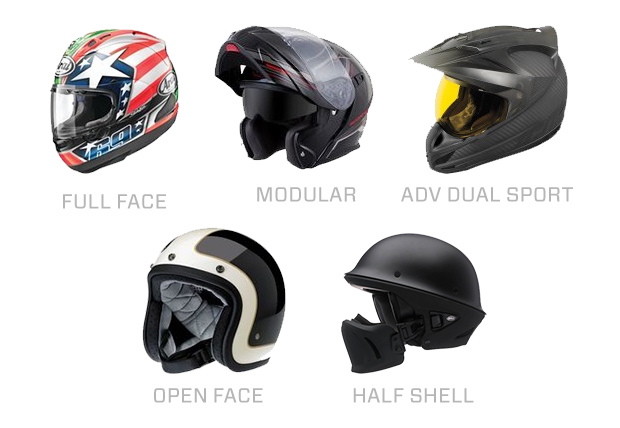Motorcycle helmets are one of the most important pieces of safety gear for motorcycle riders.There are a few things to consider when picking a motorcycle helmet, such as size, weight, comfort, and features.
Size is an important consideration when picking a motorcycle helmet because it needs to fit snugly in order to be effective. The best way to determine the correct size is to try the helmet on before purchasing it.
Weight is also an important consideration when choosing a motorcycle helmet. A heavier helmet may be more protective in the event of an accident, but it can also be more tiring to wear for long periods of time. Comfort is another key factor to consider when selecting a motorcycle helmet since it will need to be worn for extended periods of time while riding.
Look for helmets that have well-padded linings and good ventilation to keep cool while riding.
- Decide what style of riding you will be doing
- There are three main types of motorcycle helmets: full face, open face, and half helmet
- Choose the right size helmet
- A good fit is essential for comfort and safety
- Try on several different helmets before purchasing one
- Consider other features such as ventilation, removable liners, and Bluetooth capability when selecting a helmet
- Make sure the helmet you select is DOT (Department of Transportation) certified to ensure it meets safety standards

Credit: www.budgetdirect.com.au
How Do I Know My Head Shape for Motorcycle Helmet?
There are a few things to consider when choosing a motorcycle helmet that will fit your head correctly. First, you need to measure the circumference of your head using a soft measuring tape. Start at your forehead, just above your eyebrows and wrap the tape around the back of your head, over your occipital bone.
Make sure the tape is level all the way around and take note of the measurement. This will be your helmet size.
Next, you need to determine what shape your head is.
An easy way to do this is by looking at yourself in the mirror with your hair pulled back away from your face. Generally speaking, there are four different types of head shapes: round, oval, oblong/rectangular, and triangular. If you have a round shaped head, the width and length measurements will be about equal with very little tapering.
For an oval shaped head, the length will be longer than the width with some tapering from front to back. An oblong or rectangular shaped head is similar to an oval but with even more pronounced tapering from front to back. And finally, for a triangular shaped head, one side (usually the rear) will be noticeably narrower than the other two sides (forehead and jawline).
Once you know both your helmet size and shape, finding a motorcycle helmet that fits should be fairly straightforward. However, it’s always best to try on a few different helmets before making a purchase since everyone’s individual anatomy can cause slight variations in fitment even within these general categories. And don’t forget – safety should always come first when choosing a motorcycle helmet so make sure whichever one you choose meets DOT standards and has been properly certified!
What Motorcycle Helmet Should I Choose First?
When it comes to choosing a motorcycle helmet, there are many factors that come into play. The most important factor is safety, of course. But beyond that, you need to consider comfort, fit, style and budget.
With so many options on the market, it can be overwhelming trying to choose the right one. But don’t worry, we’re here to help.
Let’s start with safety.
All helmets must meet certain safety standards set by the US Department of Transportation (DOT). Look for a helmet that has a DOT sticker on it. Beyond that, there are other safety certifications to look for such as Snell or ECE.
These certify that the helmet has undergone rigorous testing and meets even higher safety standards.
Next up is comfort. A comfortable helmet is one that you’ll actually want to wear while riding.
Pay attention to things like padding, ventilation and weight when choosing a helmet. You don’t want something so heavy that it’s uncomfortable to wear or so hot that you’re constantly sweating while riding. try on different helmets until you find one that feels good on your head.
Fit is also important when it comes to comfort and safety. A properly fitting motorcycle helmet should be snug but not too tight . It should sit low on your forehead and shouldn’t move around when you move your head .
Again , try on different helmets until you find one with the right fit .
Make sure to also check out our guide on how to measure for a motorcycle helmet if you’re unsure about what size to get .
Once you’ve found a safe , comfortable and well-fitting helmet , then you can start thinking about style . Do you want a full face or open face helmet? What color do you want ? There are literally hundreds of different styles of motorcycle helmets out there , so take your time browsing until you find one that suits your taste .
And finally , don’t forget about budget . Helmets can range in price from $50 all the way up to $1000 or more . Set yourself a budget before starting your search and try not to go over it . Keep in mind though that usually , the saying goes “you get what you pay for” applies here – cheaper helmets tend to have fewer features and may not provide as much protection as more expensive ones .
So there you have it – everything you need to know about choosing your first motorcycle helmet .
What Should I Look for When Buying a Helmet?
When it comes to buying a helmet, there are a few things you’ll want to keep in mind in order to make sure you get the best possible product. Here are a few tips:
1. Make sure the helmet is certified.
In the United States, helmets must meet certain safety standards in order to be sold. These standards are set by the U.S. Consumer Product Safety Commission (CPSC). Look for a sticker on the helmet that says it meets CPSC standards.
2. Choose the right size. A helmet should fit snugly but not too tightly on your head. It should sit level on your head and shouldn’t rock back and forth or side to side when you move your head.
Use a tape measure to find out your head circumference and then try on helmets until you find one that fits well.
3. Pick a style that suits your needs. Helmets come in different styles, each with its own advantages and disadvantages.
For example, road bike helmets tend to be very lightweight and aerodynamic, but they don’t provide as much protection as mountain bike helmets which are heavier and have more coverage around the sides and back of the head. Choose the style of helmet that will work best for the type of riding you do most often.
4. Consider extra features such as ventilation or visors/sunglasses holders .
Some helmets come with additional features that can improve comfort or convenience while riding . For instance , some mountain bike helmets have large vents to help keep your head cool , while others have sunglasses holders attached so you can easily keep track of your glasses while riding . Decide what features are important to you and look for a helmet that has them .
5 Try it on before you buy it . The best way ensure proper fitment is try it on before making purchase This also allows an opportunity check how well ventilated And how easy is use any adjustments straps
How Do I Choose a Safe Motorcycle Helmet?
When it comes to choosing a motorcycle helmet, safety is paramount. But with so many different helmets on the market, how can you be sure you’re choosing the safest option? Here are a few things to keep in mind when selecting a motorcycle helmet:
1. Look for a DOT certification sticker. The Department of Transportation (DOT) has strict safety standards for motorcycle helmets that must be met in order for the helmet to be legally sold in the United States. So, if you see a DOT certification sticker on a helmet, you can rest assured that it meets or exceeds those safety standards.
2. Choose a full-face helmet. A full-face helmet offers the most protection for your head and face in the event of an accident. And while they may be slightly more expensive than other types of helmets, they’re definitely worth the investment when it comes to your safety.
3. Make sure the fit is snug. A properly fitting helmet should be snug but not too tight. It should sit level on your head and shouldn’t move around when you move your head from side to side or up and down.
How To Size and Buy a Motorcycle Helmet
How to Determine Head Shape for Motorcycle Helmet
When it comes to choosing a motorcycle helmet, one of the most important factors to consider is the head shape. Not all helmets are created equal, and finding one that matches your head shape can mean the difference between a comfortable ride and a painful one. Here’s how to determine your head shape so you can find the perfect helmet:
First, take measurements of your head. Use a tape measure or ruler to find the circumference of your head at its widest point (usually just above the ears). Then, measure from the center of your forehead to the back of your head.
Finally, measure from ear to ear across the top of your head.
Once you have these numbers, compare them to a motorcycle helmet sizing chart. Most manufacturers will have their own sizing charts on their websites; if not, there are plenty of generic ones available online.
Find the size that best matches your measurements and you’re well on your way to finding a comfortable helmet!
Conclusion
In order to pick a motorcycle helmet, it is important to consider the following: type of motorcycle riding that will be done, climate conditions, and personal preferences. For example, if you are going to be doing a lot of off-road riding in hot weather, then you will want a helmet that has good ventilation. Conversely, if you are going to be mainly riding on the freeway in cold weather, then you will want a full-face helmet with a shield.
Once you have considered these factors, you can narrow down your choices by looking at different brands and models within your budget. Finally, make sure to try on several helmets before making your final decision in order to ensure proper fit.
